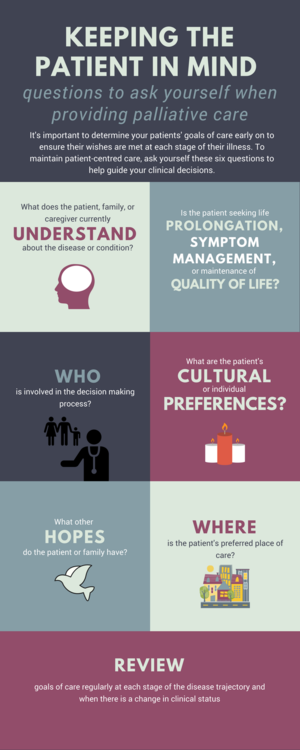Dietetics:NutritionCare/Palliative Care 2018
Creative Commons photo courtesy of Unsplash user Nathalia-bariani
Relevance of topic to dietetics student learning
What is Palliative Care?
- An approach that improves the quality of life of patients and their families facing the problem associated with life-threatening illness.
- Prevention and relief of suffering by
- Early identification and impeccable assessment
- Treatment of pain and other physical, psychosocial and spiritual problems.
RDs' Role in Palliative Care:
- Nutrition assessment and prioritize nutrition goals
- Nutrition and hydration support (per patient and family's preference)
- Liaise between patient, family and healthcare team
ICDEP Competencies
- 1.02 Comply with regulatory requirements relevant to dietetic practice
- c) Demonstrate knowledge of regulatory scope of practice, standards of practice and codes of ethics.
- 1.06 Use a systematic approach to decision making.
- a) Demonstrate knowledge of the role of ethics, evidence, contextual factors and client perspectives in decision making
- h) Make and justify decisions in consideration of ethics, evidence, contextual factors and client perspectives.”
- 2.01 Select appropriate communication approaches
- a) Demonstrate knowledge of common opportunities for and barriers to communication.
- b) Demonstrate knowledge of common communication techniques, and their appropriate uses.
- 2.04 Use effective interpersonal skills
- f) Demonstrate empathy.
- g) Demonstrate knowledge of ways to establish rapport in communication.
- 3.01 Assess nutrition related risks and needs
- e) Demonstrate knowledge of methods to obtain perspective of client, family and/or relevant others.
- 3.02 Develop nutrition care plans
- a) Demonstrate knowledge of principles for prioritization of nutrition care goals based on risk and available resources.
- b) Demonstrate knowledge of ways to identify and select appropriate nutrition interventions.
- 3.03 Manage implementation of nutrition care plan
- a) Identify ways to implement nutrition interventions.
- b) Identify roles of team members in supporting the implementation of a care plan.
- c) Identify strategies to communicate nutrition care plan with client, interprofessional team and relevant others.
Summary of key principles
Counselling Strategies
- End-of-Life conversations initiated early (usually by MD)
- Identify & monitor patient’s goals
- Patient first when balancing family members’ wish vs. patients’ wish
- Prioritize calories and protein to prevent wasting
- Focus on enjoyment (food is one of the few things patient can control)
- Think about socializing in addition to nutrition
- Be aware of cultures/traditions (Chinese culture seeks to avoid death on an empty stomach)
Self Care
- Debrief with coworkers → share feelings (most common for self care when grieving);
- Compartmentalize and leave it at work; Focus on how we can help rather than the sadness of their situation;
- Keep interactions positive, light and fun. Patients are usually happy to see a dietitian;
- Periodically, the ward may bring in a counsellor for the staff members to discuss the case and to provide emotional supports.
Legal - Advanced Directives
- Patient makes decisions about care
- Advanced directives anticipate losing autonomy:
- Power of attorney - grants another person decision making power
- Decline nutrition/hydration - no EN/PN to prolong life
- Death typically occurs in 3-14 days after stopping
- Appears to be peaceful, patients are often not hungry
- Tube feeding anecdotally appears to increase discomfort
Medical Assistance in Dying (MAiD)
- May be performed by a doctor or a nurse practitioner
- Eligibility criteria include:
- >18 years of age
- Eligible for Canadian public health services
- Capable of providing informed consent, up to and including the moment of medical assistance in dying
- Experiencing intolerable suffering due to an incurable, grievous condition
- Condition is in advanced stages, and natural death is foreseeable
- The process:
- Patient must submit written request
- Patient is given separate assessments by two different practitioners for eligibility, awareness of alternative options, and capability to make an informed decision
- 10 day period from the point of written request required before medical assistance in dying can be given
- May be given in patient’s home or living facility
Prezi Palliative Care Timeline
Prezi: Palliative Care Timeline
Click here for a Palliative Care Interactive Timeline
This Prezi timeline follows the case of a 93 year old, COPD palliative patient from diagnosis to end of life. It is important to keep in mind that while this is one representation of what a palliative patient's care in relation to dietetic practice may look like, palliative care is highly individual and should focus on the patient's wishes. This case exemplifies the importance of an interdisciplinary, team approach in providing patient centred palliative care.
Digital media learning resource #2
This infographic illustrates the steps and considerations that must be taken when determining goals of care. It is broken down into 6 questions to ask yourself to help guide clinical decisions when providing care to a palliative patient.
Online resources for further learning
BC Guidelines for Palliative Care https://www2.gov.bc.ca/gov/content/health/practitioner-professional-resources/bc-guidelines/palliative-care
This website provides provincial guidelines and they are separated into three parts: Approach to care, Pain and Symptom Management, Grief and bereavement. Each part has subparts and resources to support care in a palliative setting.
Living My Culture http://livingmyculture.ca/culture/
This website is all about familiarizing with different cultural practices and beliefs surrounding death. They cover 11 different major cultures from First nations, to Chinese, to Somali, to Pakistani, to Indian and Filipino.
BC Centre for Palliative Care http://www.bc-cpc.ca/cpc/
BC Interprofessional Palliative Symptom Management Guidelines www.bc-cpc.ca/cpc/symptom-management-guidelines/
This website provide a 300 pages long PDF that contains a large list of symptoms that may be associated with patients of palliative status and the management of these symptoms.
Student authors
Marina Balic, Mary Cao, Evan Duxbury, Violet Liao, Ya Wen, Mylo Williamson
Health care professionals that contributed: Dr. Bruce Newmarch, Dr. Eric Haywoodfarmer, Dr. Robert Baker, Kit Chan R.D., Maude Henri-Bhargava R.D., Misuzu Noguchi R.D., Soleina Maherali R.D.
Dietetics interns that contributed: Alyssa Ramanzin, Raman Rattanpal, Marilee Pumple,

